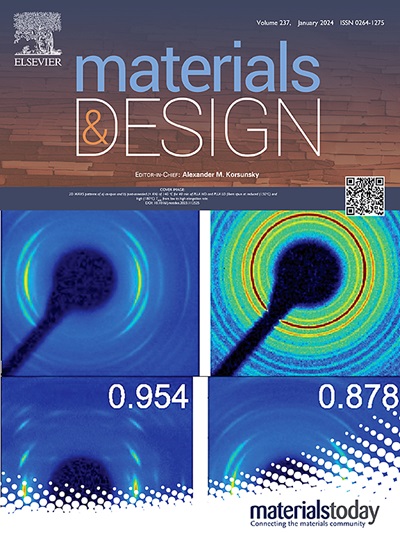梯度结构的形成和变形机制:应变硬化的作用
IF 7.9
2区 材料科学
Q1 MATERIALS SCIENCE, MULTIDISCIPLINARY
引用次数: 0
摘要
梯度结构(GS)由于其克服均质材料性能限制的能力而成为焦点。本研究采用循环扭转法制备了低碳(LC)和孪生诱导塑性(TP)钢的GS,旨在研究应变硬化能力对GS形成和变形机制的影响。TP-GS钢在硬度、位错胞(dc)、亚晶、层错(sf)和变形孪晶(dt)等方面表现出明显的梯度分布。相反,LC-GS钢只显示位错密度梯度。有限元模型(FEM)揭示了两种钢的应力梯度差异。拉伸变形后,TP-GS钢的边缘区域出现了密度更大、更细、多层次的dt,而中心区域的dc则演变为密度更大的sf和dt,并保留了显著的梯度组织。在TP-GS钢的边缘和中心区域,硬度和显微组织分布显示出“动态增强的梯度效应”,导致强度、塑性和加工硬化能力的良好协同作用。相比之下,LC-GS钢仅依赖于中心区域的变形势,导致“动态减弱梯度效应”。这一发现为GS的设计和制备提供了有价值的见解。本文章由计算机程序翻译,如有差异,请以英文原文为准。

Formation and deformation mechanisms of gradient structures: The role of strain hardening
Gradient structures (GS) have emerged as a focal point due to their capability to overcome the performance limitations of homogeneous materials. In this study, GS was prepared using the cyclic torsion method for low-carbon (LC) and twinning-induced plasticity (TP) steel, aiming to investigate the effect of strain hardening ability on the formation and deformation mechanisms of GS. The TP-GS steels exhibit a significant gradient distribution of hardness, dislocation cells (DCs), subgrains, stacking faults (SFs), and deformation twins (DTs). In contrast, LC-GS steels display only a dislocation density gradient. Finite element modelling (FEM) revealed the difference in stress gradient between two steels. After tensile deformation, denser, finer, and multi-level DTs are observed at the edge region of TP-GS steels, whereas the DCs in the center region evolve into dense SFs and DTs, preserving the significant gradient microstructure. Hardness and microstructure distributions reveal a “dynamic-enhanced gradient effect” at both the edge and center regions of TP-GS steels, leading to an excellent synergy of strength, plasticity, and work hardening ability. In contrast, LC-GS steels rely solely on the deformation potential of the center region, resulting in a “dynamic-weakened gradient effect”. This finding offers valuable insights for the design and preparation of GS.
求助全文
通过发布文献求助,成功后即可免费获取论文全文。
去求助
来源期刊

Materials & Design
Engineering-Mechanical Engineering
CiteScore
14.30
自引率
7.10%
发文量
1028
审稿时长
85 days
期刊介绍:
Materials and Design is a multi-disciplinary journal that publishes original research reports, review articles, and express communications. The journal focuses on studying the structure and properties of inorganic and organic materials, advancements in synthesis, processing, characterization, and testing, the design of materials and engineering systems, and their applications in technology. It aims to bring together various aspects of materials science, engineering, physics, and chemistry.
The journal explores themes ranging from materials to design and aims to reveal the connections between natural and artificial materials, as well as experiment and modeling. Manuscripts submitted to Materials and Design should contain elements of discovery and surprise, as they often contribute new insights into the architecture and function of matter.
 求助内容:
求助内容: 应助结果提醒方式:
应助结果提醒方式:


